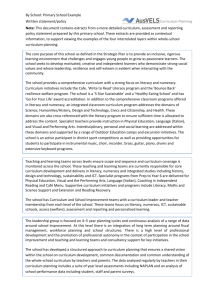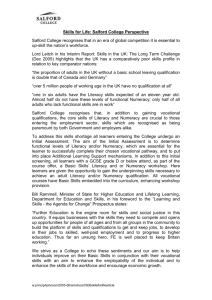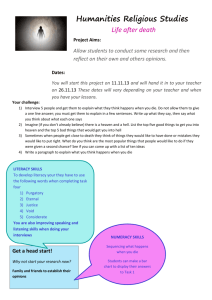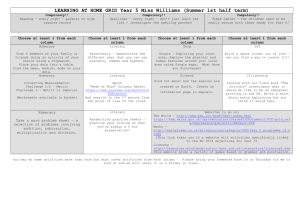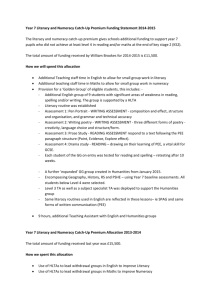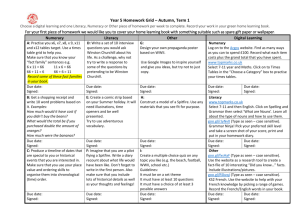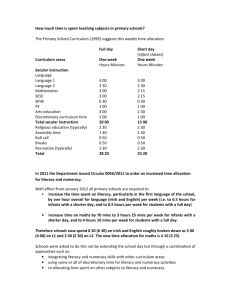Presentation
advertisement
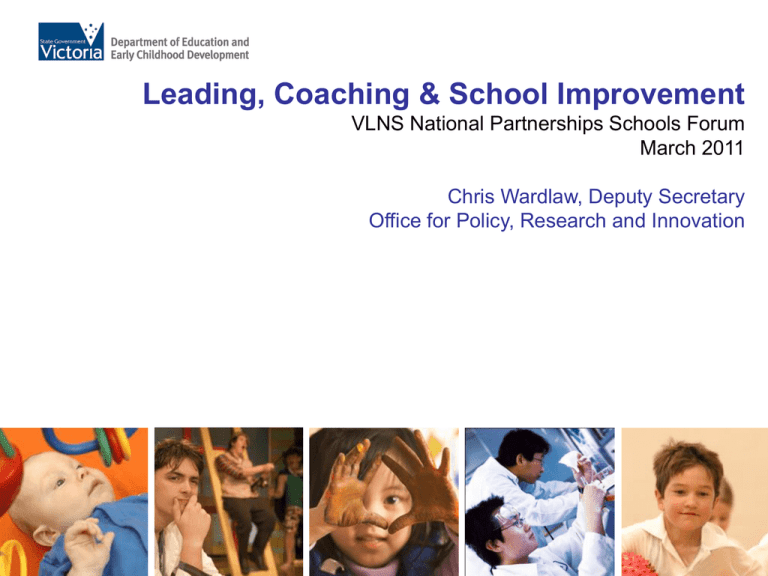
Leading, Coaching & School Improvement VLNS National Partnerships Schools Forum March 2011 Chris Wardlaw, Deputy Secretary Office for Policy, Research and Innovation Two Views on Education “What sculpture is to a block of marble, education is to the soul.” - Joseph Addison “I had a terrible education. I attended a school for emotionally disturbed teachers.” - Woody Allen 2 School leaders will need to consider… • Knowledge dimension • High reliability dimension • High performance dimension 3 The knowledge dimension… The new global environment The World has Changed ! 5 6 The game has changed! “Like never before, you have to be able to hit the target.” - Simon Dalrymple, Western Bulldogs recruiting manager Changing Views of Knowledge Sources of Knowledge Education institution Everywhere (connected classroom) Structure of Knowledge Compartmental Holistic (subjects & cross-curricular studies/enquiry projects) Understanding of Knowledge Static Dynamic (foundation knowledge, learning to learn, generic skills) Nature of Knowledge Authority Personal and contextual (teachers & students learning together) 8 Melbourne Declaration 2008 10 year national agenda Goal 1: Australian schooling promotes equity and excellence Goal 2: All young Australians become: - Successful learners - Confident and creative individuals - Active and informed citizens. Australian Curriculum What is curriculum? The core curriculum, comprising those general capabilities that all people need, use and develop through their life and the big issues of the day that all need to know about The formal curriculum, based on disciplinary rules understandings and methods The chosen curriculum that individuals students and teachers create through the choices they make The meta-curriculum comprising those activities, events and traditions that all good schools arrange to promote personal development, character and a community of learners The Australian Curriculum defines for all students the core and the formal curriculum, but leaves to schools, teachers, parents and students critical decisions about the chosen and meta curriculum 9 7 Generic Capabilities Literacy Numeracy ICT competence Critical & Creative Thinking Ethical behaviour Personal & Social Competence Intercultural Understanding Generic Capabilities Domain Expertise Cross curriculum priorities 3 Cross Curriculum Priorities One national/indigenous One regional/Asia One global/sustainability 8 Key Learning Areas English Mathematics Science Humanities and social sciences The Arts Languages Health and physical education Technologies, specifically design and technology Divergence or Convergence … ‘the fiercest debates in education circles are generally over the falsest of dichotomies …..’ Professor Michael Barber “grammar” vs “whole language” “narrative history” vs “thematic history” “back to basics” vs “real mathematics” 12 Learning reform: aligning curriculum, pedagogy and assessment Curriculum what is worth learning Pedagogy how students learn & teachers teach Alignment for student learning Assessment knowing what students have learned 13 DEECD outcomes Early childhood Best start in life Quality early childhood education & care Transition to school Schools Engagement in learning Student Achievement & improvement Youth transitions Successful transitions AEDI Measures 5 year old Children’s development in ‘Developmental domains’ 1. 2. 3. 4. 5. Physical health and well being Social competence Emotional maturity Language and cognitive skills Communication and general knowledge • 61,187 children in Victoria (94% of the 5 year-old population), national coverage was 261,203 children (97.5%) • Victoria faired well nationally, but 1 in 5 children who are entering school do not have the basic skills in place to develop and learn and achieve success at school Proportion of children developmentally vulnerable by each AEDI domain, 2009 2 or more domains 1 or more domains Communication skills Language & cognitive skills Emotional maturity Victoria Australia Social competence Physical health & wellbeing 0% 5% 10% 15% 20% 25% Percentage of children developmentally vulnerable on the Language and Cognitive Skills AEDI subdomains 20% Basic literacy 18% 16% 14.8 Interest in literacy/numeracy and memory 14% 12.6 11.4 12% 10.7 Advanced literacy 10% 9.0 8.5 8% 7.8 6.9 6.3 8.6 7.6 7.1 6.7 Basic numeracy 6% 5.3 5.0 4.4 3.5 4% 4.2 3.9 3.9 2% 0% Boys All children Girls Sex Most disad. Least disad. SES Transition Learning and Development Statement • 90% of early childhood educators reported completing a Statement. • 91% of families reported receiving a Statement. • 98% of families that received a Statement agreed to forward it to the school. • 85% of families reported completing Part 1: the family information of the Statement. Transition Learning and Development Statement cont… • 77% of Prep teachers reported having a better knowledge of the children starting school. • 58% of Prep teachers reported having a better knowledge of children with additional needs. • 46% of Prep teachers found information in the Statements useful for curriculum planning: – How Prep teachers are using the content of the Statements to inform curriculum planning is a critical part of the next phase of work around the initiative. VELS 2009 -2010 English Online Interview Data 4 Mean VELS expectation Mean EOL VELS Level Start Prep Level 0.5 0.4 End Prep Level 1 1.0 2 End Year 1 Level 1.5 1.7 1 End Year 2 Level 2 2.3 •Average scores were at or slightly above the expected VELS Level for each year •Achievement distributed across at least 3 VELS Levels from end Prep to year 2 •Substantial overlap in achievement between year levels •Most growth from start to end of prep 3 The high reliability dimension… Where do we stand? In the dark all education systems, all schools, all classrooms look similar…. But with some good data …. Important differences become apparent 22 The future is here, it is just unevenly distributed 23 Baseline Performance What improvement/gaps are we targeting? PISA 2000 PISA Reading Score800 700 600 500 400 300 200 -2.5 -2.0 -1.5 -1.0 -0.5 0.0 SES 0.5 1.0 1.5 2.0 2.5 Closing the gap between … … the ‘intended curriculum’ and … the ‘implemented curriculum’ … conscious, explicit, relentless focus on the task(s) … implementation planning … operationalising high expectations. 25 Operationalising high expectations? 26 Primary International Reading Literacy Study (PIRLS) 2006 (Primary 4) 2nd (14th in 2001) Note: 26% operating at L1 literacy levels in English 8% in 2001 27 28 2010 NAPLAN Yr 9 Writing Score Distribution 23% at or below the national minimum writing standard 12.1% below the national minimum numeracy standard Students with a mark of 89 failed to answer a single question correctly. They are mostly males who were over the national minimum writing standard in 2008. These grades can be attributed to a lack of motivation rather than lack of ability. Literacy and Numeracy 6-18 Month Strategy (Primary and Secondary) • Assessment schedule for students Prep to Year 10 • Advice on data analysis at a school, year, cohort and individual level. • Multi-faceted approach to developing and maintaining a whole school focus on literacy and numeracy, including the student intervention, professional learning and partnerships with families. • Six-term strategy published at the beginning of 2010 Key Characteristics of Effective Literacy and Numeracy Teaching P- 6 and 7-10: Differentiating support for all students The Key Characteristics of Effective Literacy and Numeracy Teaching documents quality differentiated classroom teaching for all students. The resource is organised into four headings: Teacher knowledge Literacy/Numeracy Focus Assessment Planning and Instruction Purpose: • Articulate effective practice in literacy and numeracy teaching that supports differentiation within the classroom • Build knowledge and capacity in literacy and numeracy teaching and learning with a focus on student improvement • Establish a common, shared language to describe effective practice in literacy and numeracy teaching Contemplating research……. 3 2 Research into how people learn Three principles which, when incorporated into teaching, result in the improvement of student achievement….. Bransford, Brown and Cocking (2000) How people learn: brain, mind, experience and school. National Academy Press. Http://books.nap.edu/books 33 Learning is enhanced when teachers identify and work from learners’ current knowledge and beliefs Learning is most effective when it results in wellorganised knowledge and deep understanding of concepts and their applicability Learning is enhanced by the ability to monitor one’s own learning 34 A Task: What evidence would you need to convince yourselves that your school is enacting these three principles? The high performance dimension… Rigorous benchmarking Top 2 levels (5 & 6) in maths proficiency PISA 2009 Top 2 levels (5 & 6) in maths proficiency - PISA 2009 United Kingdom United States NT TAS OECD average SA Victoria VIC NSW Australia QLD Canada New Zealand Japan ACT Finland WA Korea Hong Kong-China Shanghai-China 0% 10% 20% 30% 40% 50% 60% Top 2 levels (5&6) in reading proficiency PISA 2009 TAS OECD average United Kingdom NT SA United States VIC Victoria Hong Kong-China Canada Australia Korea NSW Japan QLD WA Finland New Zealand ACT Shanghai-China 0% 5% 10% 15% 20% 25% Aspirational or minimum standards? • 85% HK P3 students meet minimum standards in mathematics; • 96% in Australia (NAPLAN) • ? Civic Knowledge Selected jurisdictions International Civic and Citizenship Education Study 2009 Teachers make a difference John Hattie suggests …it is what teachers get the students to do in the class that emerged as the strongest component of the accomplished teachers’ repertoire, rather than what the teacher, specifically, does.” (Visible Learning, 2009 pp. 34-35) Professor John Hattie Meta research and evaluation…… 0.4 is the average size effect of various influences on learning Professor John Hattie A further task: Think about assessments undertaken in your school. Do they reflect Bloom’s Taxonomy? Assessment as feedback • • • • • • • Sharing learning intentions Sharing success criteria Using effective teacher feedback Using peers to provide feedback to each other Questioning strategically Encouraging student self-assessment Making formative use of summative assessment We can learn from other education systems (schools) even though the contexts differ. 51 Maths unplugged. Young colleagues compare notes (front row) in an abacus and mental arithmetic contest in Huaibei in eastern Anhui province, on Sunday. The contest for the northern part of the province attracted more than 200 participants aged between 4 and 8 years old. Photo: Xinhua South China Morning Post Friday May 22, 2007 The learning debate “There’s no imaginative play anymore, no pretend.” The Chinese mother Here are some things my daughters, Sophia and Louisa, were never allowed to do: • attend a sleepover • have a playdate • be in a school play • complain about not being in a school play • watch TV or play computer games • choose their own extracurricular activities • get any grade less than an A • not be the #1 student in every subject except gym and drama • play any instrument other than the piano or violin • not play the piano or violin. Tiger mum – the parenting debate “Chinese parents and teachers are increasingly aware of the need to encourage children’s individuality, while more educators in the United States are seeking to understand why U.S. children are left in the dust in global testing.” Zhang Yiwu, Director of Cultural Research Center of Peking University Questions •Benefits of rote learning •Frequent practice •Intensive testing •Acceptance of mediocre grades •Grasping as much knowledge as possible •Encouraging individuality •Thinking critically •Asking questions •Using knowledge in real life. So… Student Attitudinal Factors Confidence in mathematics (Grade 8) (TIMSS) 40% 35% 30% 25% International Hong Kong Japan 20% 15% 10% 5% 0% % of Students confident in Math …values 57 Mathematics, science and perseverance • TIMMSS • Besides the maths and science tests, students fill out a survey….a long survey (120 Qs). Many students leave many questions blank • Comparing the ranking on the tests with ranking of the average questions completed…..the rankings are the SAME ( not related!) • Singapore, South Korea, Taiwan, Hong Kong and Japan Outliers: The Story of Success Malcolm Gladwell Our young people will have…. • a deep understanding of what it means to be a Hongkonger and a citizen of China and of the world. • a sense of responsibility for all in society, regardless of their background, gender, race, social or geographical group. • perseverance and a willingness to take risks (never being defeated by failure). • an acceptance that the answers may not be totally clear at first, and that understanding can be built. • a willingness to collaborate and share, to listen to others’ points of view and to communicate their own viewpoint. 59 Perseverance Higher performance through coaching 61 62 “I don’t think about losing… I don’t think about winning either. I think about what I have to do.” Cathy Freeman Olympic Champion 400m 2000 World Champion 400m 1997, 1999 63 64 Classrooms “When locked out of the (class)room, do not peek through the keyhole. Either breakdown the door, or go away.” - Dag Hammarskojld “The problem with every reform in education is that they have all stopped at the classroom door.” - Dean Ashenden 65 E5 Instructional Model Engage Explore Explain Elaborate Evaluate 49 Multiple strategies for professional development • Demonstration/master teaching (Chinese) • Lesson study (Japanese) • Collaborative school based model (Western) • Professional knowledge and pedagogy upgrading • Specialist teaching in primary mathematics and languages • Professional education community • Teacher education providers key partners • Heavy resource commitment emphasising on-site support 67 School Support Research – Teachers and Change Condition Presentation of Theory 68 % Take Up 5 Modelling and Demonstration 10-15 Practice and Feedback 30-35 Onsite/Ongoing Coaching and Reflection 80-85 “A journey of a thousand miles must begin with a single step.” Lau Tzu The sustained literacy and numeracy improvement we are seeking will depend on the strength of… • The ideas • The organisational and infrastructure arrangements, resources, and professional capacity • The information (communication, consultation, evidence, feedback) Macro Policy and Planning (Focus on what matters most) Managing Relationships Leading Change for Improvement Develop Capacity (Attention to detail) Managing Expectations

